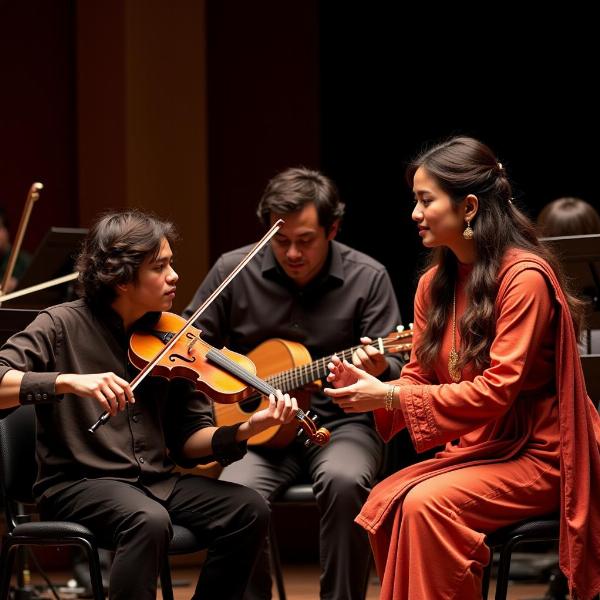Aria, a word often encountered in the world of music and opera, evokes a sense of elegance and artistic expression. But what exactly does “aria” mean in Hindi? This article will delve into the meaning, usage, and cultural significance of the word “aria” within the Hindi language context. We’ll explore its connection to Indian classical music and how it differs from Western musical traditions.
Understanding “Aria” in the Hindi Context
While “aria” doesn’t have a direct, single-word equivalent in Hindi that captures all its nuances, it’s generally understood and used in its original Italian form, particularly within musical circles. However, depending on the context, several Hindi words or phrases can convey similar meanings. For example, terms like “alap” (आलाप) or “vistar” (विस्तार) in Indian classical music describe elaborate melodic improvisations that resemble the expressive nature of an aria. These sections often serve as a platform for showcasing a musician’s virtuosity and emotional depth. Another term, “gat” (गति), refers to the melodic composition itself, which could be considered analogous to the structured melody of a Western aria.
Aria vs. Indian Classical Music: Exploring the Similarities and Differences
Although “aria” originates from Western classical music, there are interesting parallels and distinctions when comparing it to elements within Indian classical music. Both traditions emphasize melodic development and emotional expression. However, Indian classical music often prioritizes improvisation and rhythmic complexity, while Western opera tends to adhere to more structured compositions. The concept of “rasa” (रस), which refers to the aesthetic flavor or emotion evoked by a musical piece, is central to Indian classical music, similar to how an aria aims to convey specific emotions in opera.
Common Usage of “Aria” in Hindi
You’ll typically find “aria” used in Hindi when discussing Western classical music, opera, or vocal performances. For instance, a music critic might write about a singer’s powerful rendition of a famous aria. Similarly, music students learning about Western music theory would encounter the term in their textbooks. However, in everyday conversations about Indian music, terms like “alap,” “vistar,” or “gat” are more common. pratibha name meaning in hindi
How “Aria” Relates to Other Musical Terms in Hindi
Understanding “aria” in Hindi also requires considering its relationship to other musical terms. For example, “geet” (गीत) is a general term for song in Hindi, encompassing a wide range of vocal music. While an aria could be considered a type of “geet” within the Western classical music context, the two terms are not directly interchangeable. Similarly, “sangeet” (संगीत) refers to music in general, encompassing both vocal and instrumental forms. dedicative meaning in hindi
Aria’s Cultural Significance in a Globalized World
In today’s interconnected world, musical traditions are constantly influencing each other. The increasing exposure to Western classical music in India has led to a greater understanding and appreciation of concepts like “aria.” Conversely, the growing popularity of Indian classical music globally has introduced Western audiences to the rich tapestry of Indian musical forms. This cross-cultural exchange enriches both traditions and expands our understanding of musical expression.  Cross-Cultural Musical Exchange
Cross-Cultural Musical Exchange
Expert Insight:
Dr. Anika Sharma, a renowned musicologist, shares, “While ‘aria’ retains its original meaning in Hindi, its usage often comes with an implicit understanding of its Western musical context. This allows for a nuanced appreciation of both Western and Indian musical traditions.”
Pandit Ravi Shankar Mishra, a celebrated vocalist, adds, “Indian classical music, with its emphasis on improvisation and ‘rasa,’ offers a unique perspective on melodic expression that can be compared and contrasted with the structured beauty of a Western aria.”
Conclusion
“Aria,” while originating from Western classical music, has found its place within the Hindi language landscape. Although no single Hindi word perfectly encapsulates its meaning, related terms like “alap,” “vistar,” and “gat” provide valuable insights into comparable concepts within Indian classical music. Understanding the nuances of “aria” and its relationship to Indian musical traditions enriches our appreciation of the diverse world of music. culvert meaning in hindi
FAQ
- What is the literal meaning of “aria” in Hindi? There isn’t a direct literal translation, but it’s generally understood in its original Italian form.
- Is “aria” commonly used in everyday Hindi conversations? It’s more common in discussions about Western classical music than in everyday speech.
- What are some Hindi musical terms similar to “aria”? Terms like “alap” and “vistar” in Indian classical music share some similarities.
- How does understanding “aria” enhance our musical knowledge? It allows for a deeper appreciation of both Western and Indian musical traditions and their interconnectedness. farsa meaning in hindi
- Where can I learn more about Indian classical music? Numerous resources, including books, online courses, and live performances, offer opportunities to explore this rich musical tradition.
Meaning-Hindi.in offers professional translation services specializing in Hindi and a wide range of other languages. Our expertise covers various domains, including business, legal, technical, website localization, and academic translation. We provide accurate and culturally sensitive translations to bridge communication gaps and facilitate cross-cultural understanding. Need help with translating your documents or understanding cultural nuances? Contact us at [email protected] or call us at +91 11-4502-7584. Meaning-Hindi.in is your trusted partner for all your language service needs.